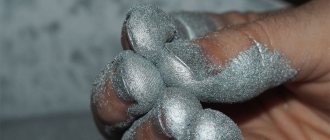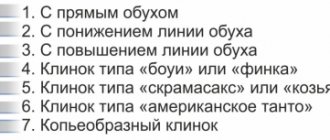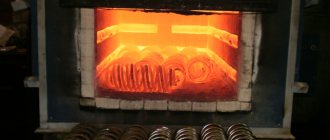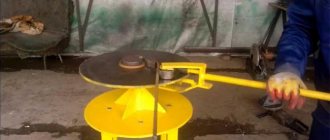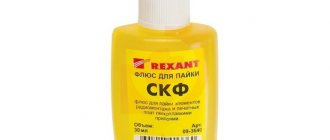Coil compression springs
Elastic elements can have different spatial forms. Historically, the first springs mastered by man were leaf springs. You can still see them today - these are springs on heavy-duty trucks. With the development of technology, people have learned to make more compact coil springs that work in compression. In addition to them, spatial elastic elements are also used.
Coil springs
Design Features
During operation, such springs take a load along their axis. In the initial position, there are gaps between their turns. The applied external force deforms the spring, its length decreases until the coils touch. From this moment on, the spring is an absolutely rigid body. As the external force decreases, the shape of the product begins to return to its original shape until it is completely restored when the load disappears.
The main characteristics describing the geometry of the part are:
- The diameter of the rod from which the spring is wound.
- Number of turns.
- Winding step.
- External diameter of the part.
The external shape may differ from cylindrical and represent one of the figures of rotation: cone, barrel (ellipsoid) and others
The winding pitch can be constant or variable. The winding direction is clockwise and counterclockwise.
Spring device
The cross-section of the turns can be round, flat, square, etc.
The ends of the turns are ground down to a flat shape.
Operating area
Cylindrical coil springs of constant outer diameter and constant pitch are used more widely than others. They are used in areas such as
- Mechanical engineering.
- Instrumentation.
- Vehicles.
- Mining industry.
- Appliances .
and in other industries.
Use of springs in everyday life
Theory [edit | edit code]
From the point of view of classical physics, a spring can be considered as a device that accumulates potential energy by changing the distance between the atoms of an elastic material.
In the theory of elasticity, Hooke's law states that the tension of an elastic rod is proportional to the force applied to it, directed along its axis. In reality, this law is not fulfilled exactly, but only for small stretches and compressions. If the stress exceeds a certain limit (yield strength), irreversible damage to its structure occurs in the material, and the part collapses or receives irreversible deformation. It should be noted that many real materials do not have a clearly defined yield point, and Hooke's law does not apply to them. In this case, a conditional yield strength is established for the material.
Twisted metal springs convert the compression/tension deformation of the spring into torsional deformation of the material from which it is made, and vice versa, the torsional deformation of the spring into tensile and bending deformation of the metal, repeatedly increasing the elasticity coefficient by increasing the length of the wire resisting external influences. Wave compression springs are similar to many series/parallel connected springs that work in bending.
Stiffness coefficient [edit | edit code]
A twisted cylindrical compression or tension spring, wound from a cylindrical wire and elastically deformed along the axis, has a stiffness coefficient
k = G ⋅ d D 4 8 ⋅ d F 3 ⋅ n , >^<4>> <8cdot d_>^<3>cdot n>>,>
d
D—wire diameter;
d
F - winding diameter (measured from the wire axis);
n
is the number of turns;
G
- shear modulus (for ordinary steel
G
≈ 80 GPa, for copper
Spring requirements
The following properties are required for the work to function effectively:
- high strength;
- plastic;
- elasticity;
- wear resistance.
To ensure the design values of these parameters, it is necessary to correctly select the material, accurately calculate the dimensions, develop and follow the manufacturing technology.
State standards determine the requirements for the manufacture of springs. According to permissible deviations, they belong to one of the accuracy groups:
- less than 5%;
- less than 10%;
- less than 20%.
Schematic representation of a spring
Strict requirements are imposed on the accuracy of geometry and surface cleanliness.
Products with scratches and other external defects that reduce the resource of the product and its service life do not meet the standard
Material requirements
The strength parameters and fault tolerance of a product are largely determined by the material from which it was decided to be made. Metallurgists distinguish special spring steels in the classification of steels. They have a specific crystal structure, determined both by the chemical composition and the heat treatment of the products. Highly alloyed alloys of increased purity and high metallurgical quality provide high elasticity and ductility, and are able to retain their physical and mechanical properties after repeated deformations.
Steel 60S2A
Spring alloys 60S2A, 50HFA and stainless steel 12Х18Н10Т have gained popularity among mechanism designers.
Application of springs [edit | edit code]
A spring is one of the most widely used elements of mechanisms, structures, and devices. Used to compensate for dimensional inaccuracies, wear, vibration removal, as an energy storage device, for simple measurement of pressure, weight, forces and accelerations; protection against shocks and overloads.
In stationery [edit | edit code]
- paper clips and stationery pins
- fountain pens and mechanical pencils
- staplers and hole punches
In construction [edit | edit code]
- The simplest door closers without dampers for gates and doors of intensive use, in cold climates for vestibules.
- In return mechanisms of manual blinds, roller shutters and heavy sectional doors.
- In directional valves in public places.
- In elevator buffers.
- In buildings and structures on unstable soils, in geologically active areas, as a seismic wave absorber.
In molds and dies [edit | edit code]
Compression springs with a rectangular wire cross-section are used in molds and dies; they are called tool springs. Thanks to the rectangular cross-section of the wire, the spring has more rigid spring properties with relatively small dimensions, which is very convenient for placing them in molds and dies.
In firearms [edit | edit code]
- Mainspring, recoil spring, magazine spring
- In gun simulation, an airsoft gun is a spring commonly used to push the projectile in spring-piston rifles.
In constant force mechanisms [edit | edit code]
The design of the mechanism or the spring itself ensures a constant force on the load-carrying element over a certain range of movement.
- Constant force supports for pipelines
- Constant force or torque roller springs
- Pipe fitting seals
- Specified load for floating bearings
Springs are elastic structural elements that serve to accumulate or dissipate mechanical energy. They surround us on all sides - under the keys of the computer keyboard, in the car suspension and in the lifting mechanism of the sofa. The most common are coil compression springs. There are several ways to make them.
Features of the technology
The technological process for manufacturing elastic elements depends on the technical requirements for the design. Making a spring is not as easy as an ordinary part, which should not have special elastic properties. This requires special equipment and equipment.
Winding of springs with a round coil section is carried out using the following methods:
- Cold. Suitable for small and medium sizes (wire diameter up to 8 mm).
- Hot. For large diameters.
Spring coiling technology
After winding, the elastic elements are subjected to various types of heat treatment. During this process, the product acquires the specified properties.
Equipment and fixtures used
Making springs requires a variety of equipment to best suit the requirements of each step of the process.
Winding is carried out either on special spring-coiling machines, or on turning equipment converted for these purposes. It is also possible to use manual equipment or specialized semi-automatic machines. Further processing - mechanical - is carried out by face grinding machines, and thermal - in hardening and tempering furnaces. Important: to prevent warping during heat treatment, special mandrels are used. For small parts they are used during tempering, while large parts are hardened on a mandrel.
Quality control is also carried out on special equipment designed specifically for this process.
Cold coiling technology without hardening
First you need to do preparatory operations. Before a workpiece is wound from wire, it is subjected to a patenting procedure. It consists in heating the material to the plasticity temperature. This operation prepares the wire for the upcoming change in shape.
During the winding operation the following parameters must be maintained:
- External diameter of the product (for some parts the internal diameter is standardized).
- Number of turns.
- Winding pitch.
- The total length of the part, taking into account subsequent operations.
- Compliance with the geometry of the end turns.
Cold coiling without tempering
Next, the end turns are ground down to a flat state. This must be done to ensure high-quality support for other structural parts, to prevent their destruction and the spring from slipping out.
The next stage of the technological process is heat treatment. Cold coiling of springs involves only tempering at low temperatures. It allows you to increase elasticity and relieve mechanical stresses that arise during winding.
It is extremely important to strictly adhere to the design heat treatment schedule, carefully controlling temperature and holding time.
After heat treatment, it is necessary to carry out test and control operations.
Further, if necessary, protective coatings can be applied to prevent corrosion. If they were applied by galvanic method, the products are reheated to reduce the hydrogen content in the surface layer.
Manufacturing of springs and leaf springs
In tractors and agricultural machines, cylindrical compression and tension springs made of round wire are widely used (Fig. 24). Typically, springs are made of wire with a diameter of 1.5 to 10 mm. According to the manufacturing accuracy, springs are divided into three groups. The first group includes springs with permissible deviations in forces and elastic movements of ± 5%, the second group - ± 10% and the third group - ± 20%. In agricultural machines, as a rule, springs of 3 accuracy groups are used. Springs for engine valves, fuel pump regulators, and bypass valves for tractor hydraulic systems are manufactured according to accuracy groups 1 and 2.
Rice. 24. Types of springs:
a – compression; b – stretching
Compression springs are wound by open coiling with a pitch that provides clearance between the coils by 10...20% greater than the calculated axial elastic displacements of each coil. The calculated axial elastic displacement of the coil is determined at the maximum working load. The end coils are pressed against adjacent coils, and the end surfaces of the spring are ground perpendicular to its axis. This achieves the transfer of load to the spring along its axis.
Extension springs are equipped with trailers to transmit force to the springs. Often trailers are made in the form of bent turns. Tension springs are wound with a closed coil in such a way that the initial tension (pressure between turns) is ensured. This tension is selected equal to 1/4...1/3 of the maximum force at which the spring is tested.
To avoid bending of the axis of the compression spring under load (loss of longitudinal stability), the length of the spring usually does not exceed 4...6 outer diameters. The length of the extension spring is not structurally limited.
Springs are made from high-carbon steels 65 and 70 and alloy steels 65G, 60S2A, 50HFA, etc. Cold-drawn carbon steels 65 and 70 have mechanical properties in the supplied state that allow them to be used without hardening (hardness 255...285 HB). After manufacturing, springs made from these steels are only tempered to relieve stresses arising during cold drawing and coiling. Springs made from hot-rolled and annealed steels are hardened and tempered to a hardness of 40...50 HRC.
Carbon spring wire is produced with a diameter of up to 8 mm in three main classes: normal strength (III), increased strength (II) and high strength (I).
The technological process of manufacturing compression springs includes the following main works: winding, cutting to size, preloading the end coils, heat treatment, grinding the ends of the spring, bonding, control and testing. In the manufacture of tension springs, the following is carried out: winding, cutting to size, bending of the outer turns to form hooks, heat treatment, control and testing.
The production of springs from wire with a diameter of up to 8 mm is usually done by cold coiling, and from wire with a larger diameter - by hot coiling. For winding, mandrels are used, the diameter of which during cold winding is slightly smaller than the internal diameter of the spring, taking into account the elastic deformations of the spring coils, and during hot winding it is equal to the internal diameter of the spring. The heating temperature of the wire during hot coiling, depending on the diameter of the spring, is selected from 800 to 1000 °C. In mass production, cold coiling of springs is carried out using automatic machines.
Springs from wire with a diameter of up to 4 mm can be produced using automatic machines using the mandrelless method. In Fig. Figure 25 shows a diagram of the operation of such a machine. The wire, passing through straightening and transport rollers, is fed to fingers 7, which bend it into a spiral, so that a spring of the required diameter is formed. The spring of the required length is cut off by knife 5 at stop 6. All actions of unwinding the wire from the coil and feeding it into the machine, winding the spring, fixing the specified spring pitch, stopping the wire feed and separating the workpiece are performed automatically.
Rice. 25. Scheme of operation of the machine for arborless coiling of springs:
1 – wire; 2 – correct rollers; 3 and 4 – transport rollers;
5 – knife; 6 – emphasis; 7 – fingers; 8 – guides
In mass production, springs are wound on lathes using cylindrical mandrels. The end of the wound wire is fixed to a mandrel installed in the centers or clamped in a chuck. The machine is adjusted to the required technological winding step. When winding, to create the required tension, the wire passes between two blocks (wooden) fixed in the tool holder. The necessary force of pressing the pads against the wire is created using the clamping bolts of the tool holder.
If the equipment does not allow the springs to be wound with the required pitch, then after winding they are separated in pitch. Cold-wound springs are cold-wound, while hot-wound springs are. – at a temperature of 700...850 °C depending on the diameter of the wire. The end coils of the compression spring must be preloaded so that at a length of 3/4 - 1 coil they almost touch the adjacent working coils. After grinding the end, the thickness of the free end of the coil should usually be about 1/4 of the wire diameter. In powerful springs, to facilitate the operation of grinding the ends, the ends of the wire are pre-pulled hot. When winding on a lathe, preloaded turns are formed after the longitudinal feed of the support is turned off.
Springs obtained by cold method from pre-prepared material (carbon cold-drawn steel), after coiling, are subjected only to tempering in oil or salt baths at a temperature of 250...320 °C for 15...30 minutes, depending on the diameter of the wire. Springs, hot-wound or cold-wound from annealed material, are subjected to heat treatment, which is divided into preliminary (normalization and tempering) and final (hardening and subsequent tempering). Thus, springs made of 60C2A wire, during preliminary heat treatment, are heated to a temperature of 850...860 °C for 20...40 minutes and cooled in air. During the final heat treatment, the springs are hardened in oil with preheating to a temperature of 850...870 °C and holding for 20...50 minutes. After hardening, tempering is carried out for 30...60 minutes with heating to a temperature of 400...425 °C. The hardness of such a spring after heat treatment should be 40...49 HRC.
In mass and large-scale production, the ends of small-sized springs are ground on surface grinding machines with the end of a wheel. Special machines are also used to grind both ends of the spring simultaneously.
Cold coiling technology with quenching and tempering
The first stages of the technology coincide with the previous process. Changes begin at the heat treatment stage. It is carried out in several stages:
- Hardening. The workpiece is heated to a given temperature and held for 2 to 3 hours. Next, it is subjected to rapid cooling by immersing it in a container with mineral oil or saline solution. During the hardening stage, the workpieces must be in a horizontal position. This will avoid deformation
- Vacation. The workpiece is heated to 200-300° and kept for several hours to relieve internal stresses and improve elastic properties.
Further measuring and control operations are also carried out. The workpieces that have passed the inspection are sent for sandblasting to remove scale. If necessary, shot blasting should also be done to increase the strength of the surface layer of the metal.
The process is completed by applying a protective coating.
Types of springs [edit | edit code]
By type of perceived load
:
- compression springs;
- extension springs;
- torsion springs;
- bending springs.
Extension springs
— designed to increase in length under load. In an unloaded state, they usually have closed turns. There are hooks or rings at the ends to secure the spring to the structure.
Compression springs
— designed to reduce length under load. The coils of such springs do not touch each other without load. The end coils are pressed against the adjacent ones and the ends of the spring are ground. To avoid loss of stability, long compression springs are placed on mandrels or cups, or smaller wave springs are used.
In tension-compression springs, under the influence of a constant force, the coils experience two types of stress: bending and torsion.
Bend spring
- used to transmit elastic deformations with minor changes in the geometric dimensions of a spring or spring package (springs, disc springs). They have a variety of simple shapes (torsion bars, retaining rings and washers, elastic clamps, relay elements, etc.)
Torsion springs
- can be of two types:
- torsion bar - a rod that exerts torsion (has a greater length than a coil spring)
- twisted springs that work for torsion (as in clothespins, mousetraps and stationery hole punches).
The Bourdon spring is known in instrument making
- a tubular spring in manometers for measuring pressure, playing the role of a sensitive element.
Hot coiling technology with quenching and tempering
Before winding, the workpiece is heated to plasticity temperature using one of the following methods
- muffle furnace;
- gas-burner;
- high frequency heating.
Next, the workpiece is supplied to the coiling equipment. The geometry is adjusted and flat ends are formed.
Heat treatment includes hardening and low-temperature tempering.
Heat treatment schedules are constructed based on the properties of the material and the dimensions of the workpiece.
Operating mode of the quenching and tempering furnace line
Next comes the control and measuring stage. Manufacturing is completed by applying anti-corrosion protection.
